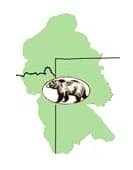Yellowstone Ecosystem Subcommittee Invites Public to Attend Spring Meeting in Jackson, Wyoming on March 26 & 27
OutdoorHub 03.17.14

The Yellowstone Ecosystem Subcommittee (YES) of the Interagency Grizzly Bear Committee (IGBC) will hold its spring meeting in Jackson, Wyoming on March 26 and 27, 2014 and invites the public to attend. Frank van Manen of the United States Geological Survey (USGS), leader of the Interagency Grizzly Bear Study Team (IGBST) will be speaking on a recently accepted scientific article by the IGBST that refutes a previous article by Doak and Cutler that had critiqued the methods used by the IGBST to estimate grizzly bear population size and trend in the Yellowstone Ecosystem.
The meeting will take place at the Snow King Resort in Jackson, Wyoming. The meeting starts at 1:15 p.m. on Wed., March 26, and ends at 4:45 p.m. Proceedings will resume at 8:00 a.m. on Thurs., March 27, and conclude by 11:30 a.m.. The public is welcome to attend all sessions and time for public comments will be included at the end of each day.
The Yellowstone ecosystem grizzly bear recovery area includes all of Yellowstone & Grand Teton National Parks, as well as portions of northwest Wyoming, eastern Idaho, and southwest Montana. The intermountain West has always been home to bears. Even in those times and places where humans worked to eliminate grizzly bears, black bears were generally allowed to exist. Today, grizzly bears with the help of man have made incredible strides towards recovery. This means that as both species of bears go about their routines to survive, an ever expanding human presence means that the opportunity for an encounter with a bear is possible. This closeness to wildness is why many people choose to live, work, and visit the region.
The price for this opportunity to experience nature firsthand means that humans need to be as educated as possible about how bears live. Knowing what bears need to survive and what human’s do that can cause conflicts is important to reducing the chance for problems. Bears generally avoid humans because they have learned contact usually has negative results. Many people unfortunately have never had the chance to learn about bears or intentionally make choices that could put themselves or bears at risk.
Making decisions to decrease the chance of conflicts is not difficult, but it does require commitment. For those living in bear country it means learning what attracts bears and making the needed changes to keep bears from getting into trouble. People that are recreating or working in bear country should learn about identifying bear sign and what to do if they encounter a bear. Making bears aware of your presence and caring bear spray should become reflex actions for those spending time out in bear country.
Individuals with special needs can contact Gregg Losinski at glosinski@idfg.idaho.gov or through the Idaho Relay Service at 1-800-377-3529 (TDD). A copy of the meeting agenda is available at the YES portion of the Interagency Grizzly Bear Committee website at http://www.igbconline.org/index.php/yellowstone-ecosystem-subcommittee.

